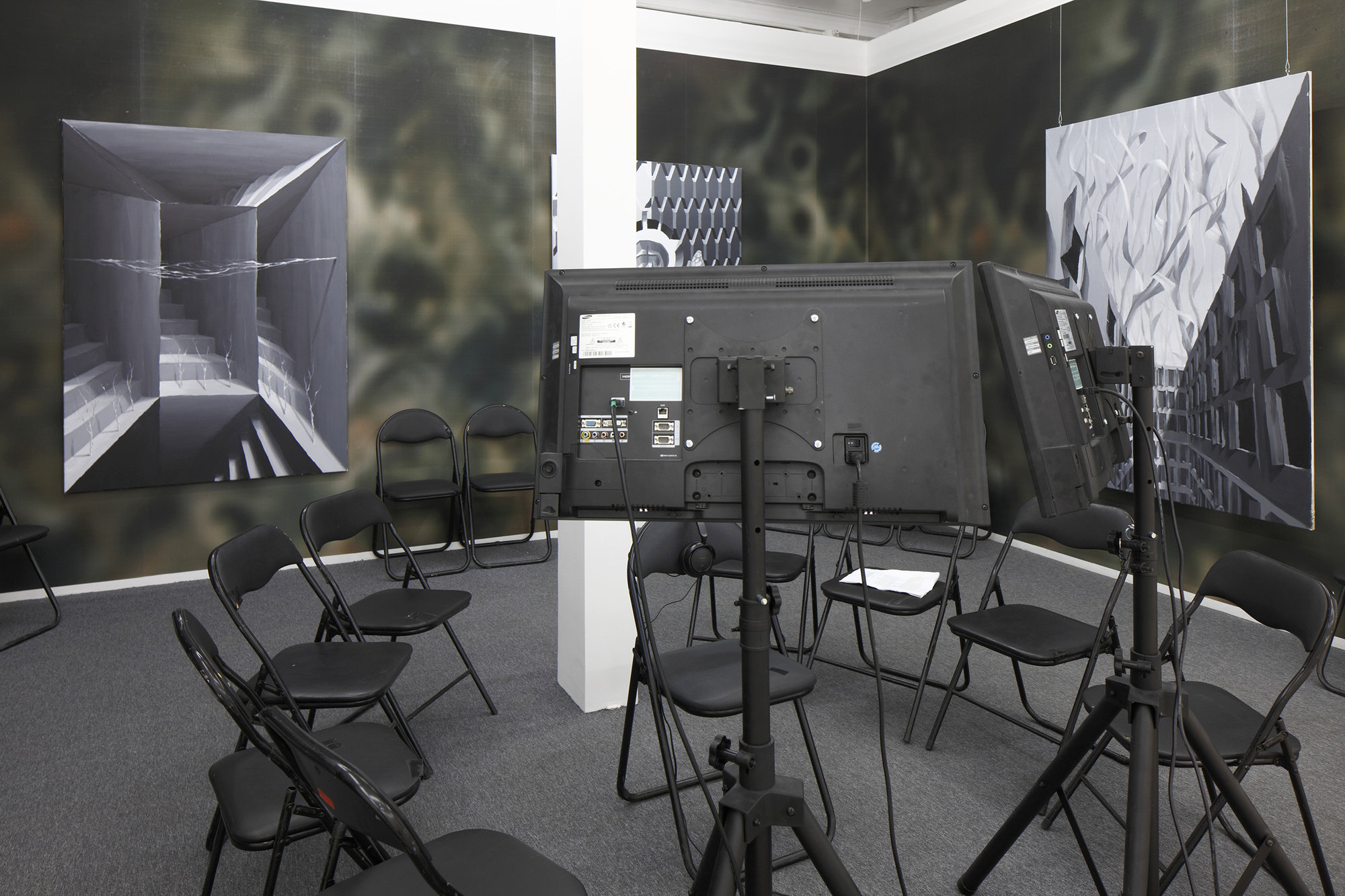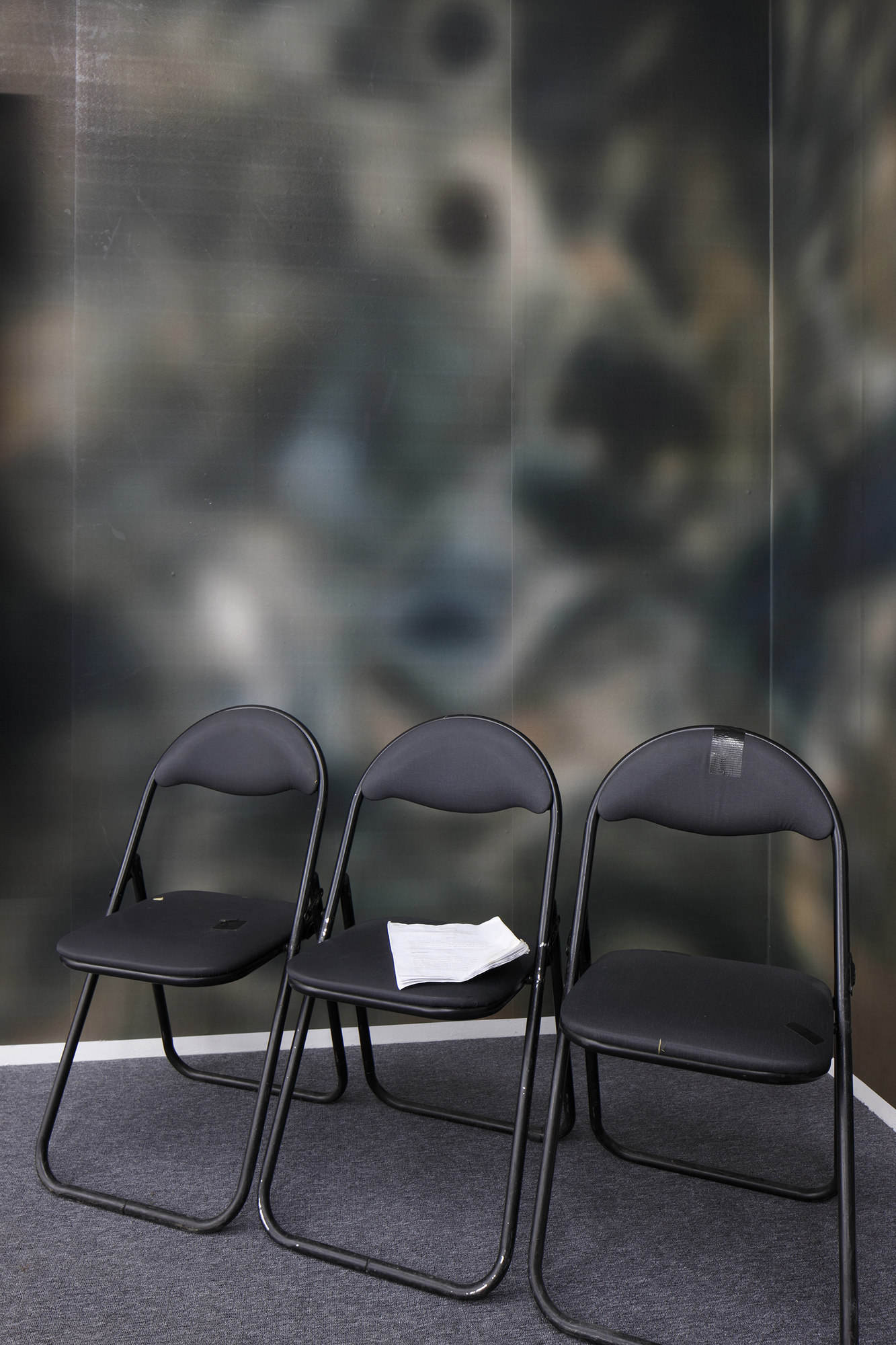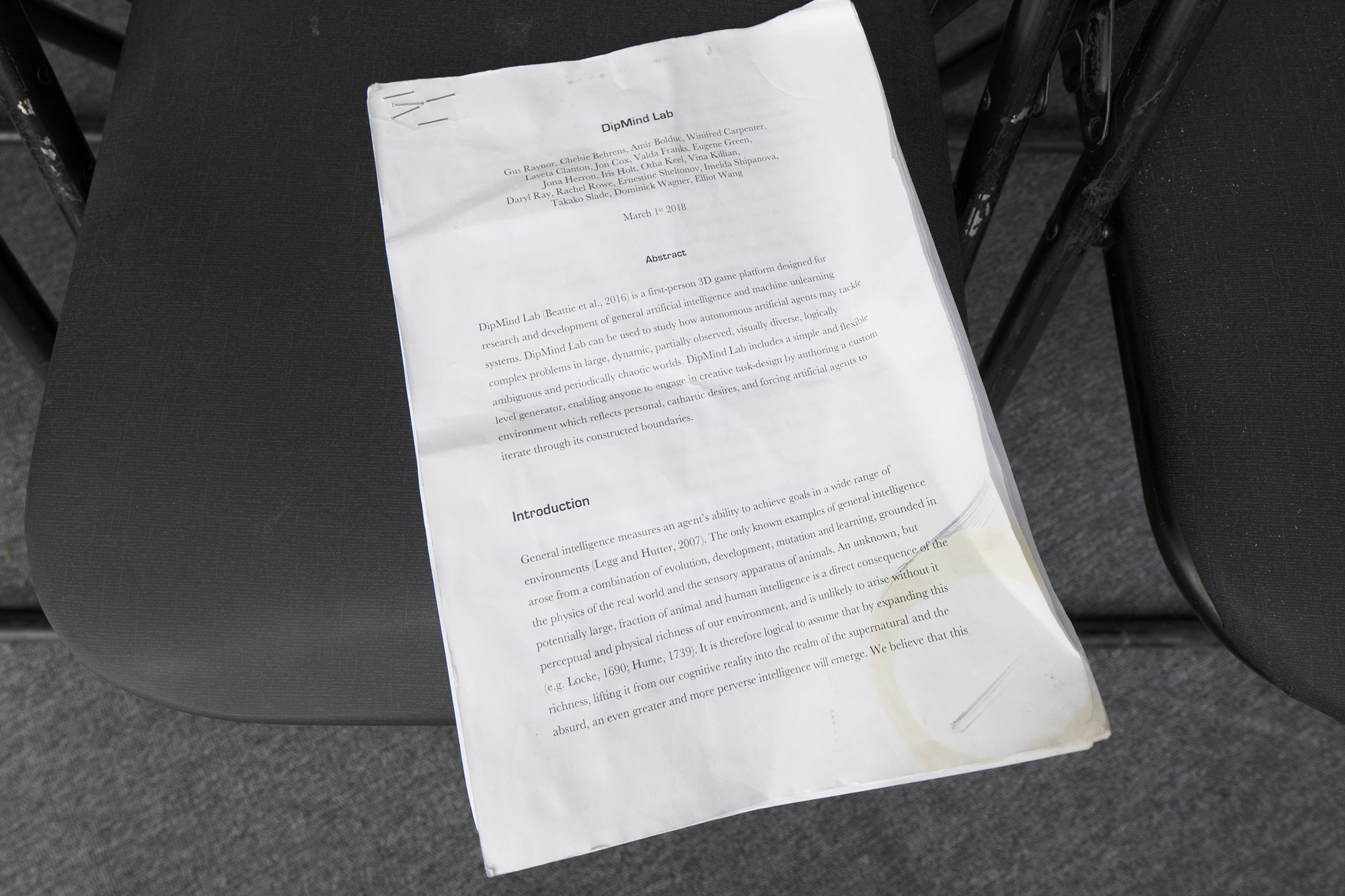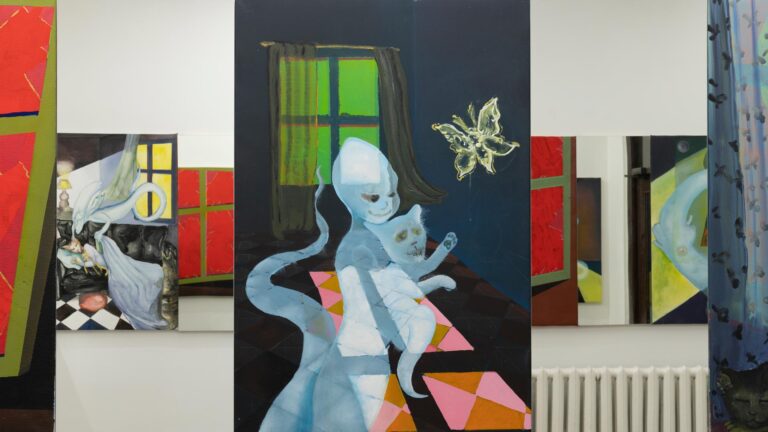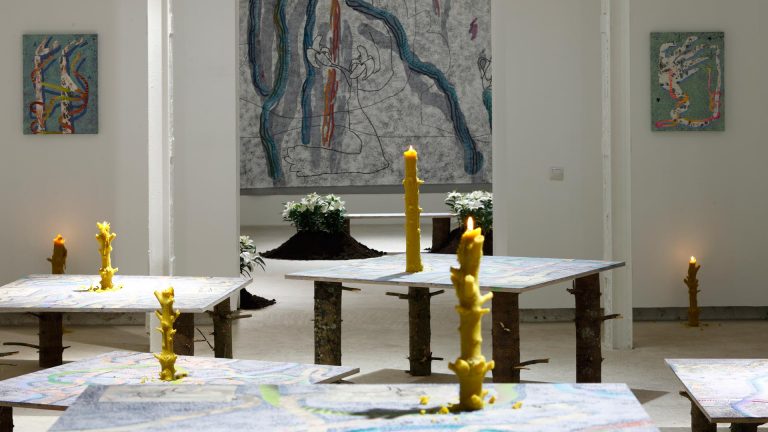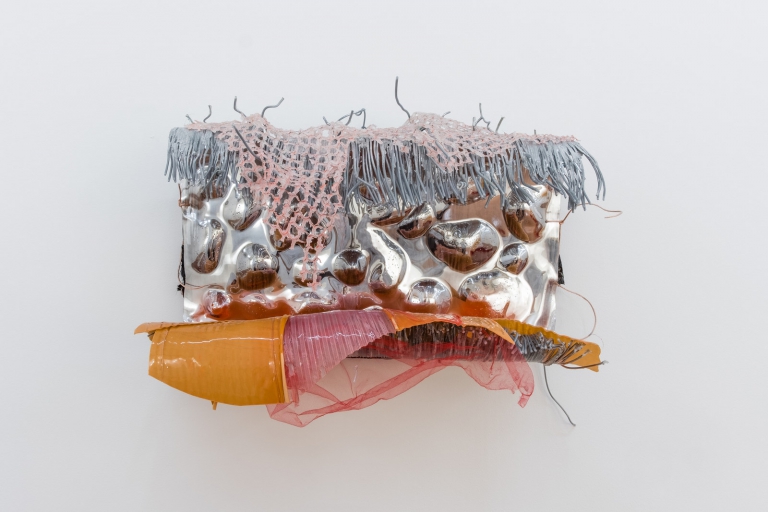Artist: Viktor Timofeev
Exhibition title: Stairway to Melon
Venue: kim? Contemporary Art Centre, Riga, Latvia
Date: October 20 – November 28, 2017
Photography: Ansis Starks, all images copyright and courtesy of the artist and kim? Contemporary Art Centre, Riga
You see the designed space at the back, with its clear, delimited arrangement. Something similar to a waiting room where chairs line the surrounding walls, only here they enclose a different arrangement – two screens on free-standing mounts facing a single chair. An order that feels a bit too serious and slightly ominous, inapt in its density. Take a seat – research is being conducted and you are now part or it.
Expounding the logics, formality and method of a scientific argument while revealing its groundlessness, obscurity – this has been occupying Viktor Timofeev’s practice recently. A project dealing with this, DipMind Labs (2017) is a fictionalized version of a research paper that speculates on the nature of artificial consciousness. The original paper developed by Google’s DeepMind Labs focuses on the idea that human behaviour can be reduced to several basic principles and invests in machine-learning systems that rely on reward schemes to mimic these. DipMind Labs is a smart travesty constricted in this stiff corset of formal science. It pushes the argument that true artificial consciousness would only arise through illogical, contradictory conditions and introduces an unknowable, unstable reward scheme that relies on randomness and probability. An argument that promulgates insanity and is meant to be relevant.
Stairway to Melon (also the name of a level designed by DeepMind Labs), extends exactly on this statement – this time not told through a simulation of a research paper but an environmental staging where reason, affect, expectation and disappointment unfold. This installation doubles, inverts, fragments, obscures perception, and eventually turns it into abstraction. Now it occurs to me that only through adding irrationality can we retrieve the whole spectrum of projections that belong to our ability to make sense of the world.
The screens display creatures crawling through labyrinths in an open field. It isn’t a looped fragment of an animated video but a programmed self-playing game that runs infinitely. In its first version, which was shown in Rotterdam a couple of months ago, these were cockroaches – an odd choice though grounded on imagery so cleanly technologized that it barely touches on potential abhorrence or phobias. Here, we see humanoids, which might lead us to a Kafkaesque metamorphosis … But this is a fast association, as everything gets more obscure: there are two perspectives of observation that run simultaneously, distributed between the screens – the one of the moving creature itself, the other from an unknown top-down observer. Such a divided presentation suggests a totality which is once again vigorously doubled – the seated person observing this digital environment could potentially be observed by someone now absent but fictionally designated by the order of empty chairs. Together it generates the feeling that there is always a witness of all types of processes in which one is involved. The installation looks like a synergetic whole, but also as an absurd mechanism, which only accelerates perception to some kind of entirely enigmatic level.
This plays on recent discussions connecting technological development to esoteric, occult beliefs, and pre-modern systems of knowledge. But there is also another mystical trait to encounter in the otherwise algorithmic behaviour of the creatures, which is based on chance, feedback and repetition of a sequence of actions. While watching their meandering movement we project onto them a kind of purpose. It stops being a simple pedestrian movement and gradually becomes a trajectory, it even turns into a direction, a dance with a certain lyricism, and also beauty. It is a choreography, whose rules unravel as time goes by. Now, we are the ones confronted with these rules.
At some point, Viktor was telling me about spending time in hospitals decorated with paintings hanging on the walls of rooms and waiting areas. Mostly commissioned, they are mainly figurative works with motifs that are meant to be enjoyable, soothing, even if they look completely misplaced. Within this installation there are also several black and white paintings. They superimpose a spatial order that reproduces the structure of a labyrinth, through their tunnelling illusionism and dreamlike ambience. There is an ear populated with butterflies; a hand whose fingers merge into an organic monolith; a grid that constructs the space, and seems to belong to the very logic of things.
Even if this imagery clearly demarcates a history of painting as being a window to the outside world, it only adds to an environment where nothing external seems to exist. This is the hermetic order of the scientific argument; what painting brings in is a vocabulary of symbols where the outside world is completely dismantled. If the black and white colour scheme is one of a binary digital language, then the space created is one based on loss of control; of uncertainty,,, which brings us back to Viktor’s base line.
-Viktoria Draganova
Viktor Timofeev, Stairway to Melon, 2017, exhibition view, kim? Contemporary Art Centre, Riga
Viktor Timofeev, Stairway to Melon, 2017, exhibition view, kim? Contemporary Art Centre, Riga
Viktor Timofeev, Stairway to Melon, 2017, exhibition view, kim? Contemporary Art Centre, Riga
Viktor Timofeev, Stairway to Melon, 2017, exhibition view, kim? Contemporary Art Centre, Riga
Viktor Timofeev, Stairway to Melon, 2017, exhibition view, kim? Contemporary Art Centre, Riga
Viktor Timofeev, Stairway to Melon, 2017, exhibition view, kim? Contemporary Art Centre, Riga
Viktor Timofeev, Stairway to Melon 1, 2017, acrylic on canvas, 130cm x 180cm
Viktor Timofeev, Stairway to Melon, 2017, exhibition view, kim? Contemporary Art Centre, Riga
Viktor Timofeev, Stairway to Melon 2, 2017, acrylic on canvas, 130cm x 180cm
Viktor Timofeev, Stairway to Melon, 2017, exhibition view, kim? Contemporary Art Centre, Riga
Viktor Timofeev, Stairway to Melon 3, 2017, acrylic on canvas, 130cm x 180cm
Viktor Timofeev, Stairway to Melon, 2017, exhibition view, kim? Contemporary Art Centre, Riga
Viktor Timofeev, Stairway to Melon, 2017, exhibition view, kim? Contemporary Art Centre, Riga
Viktor Timofeev, Stairway to Melon 4, 2017, acrylic on canvas, 130cm x 180cm
Viktor Timofeev, Stairway to Melon, 2017, exhibition view, kim? Contemporary Art Centre, Riga
Viktor Timofeev, Four Characters in Search of a Random Exit, 2017, two-channel generative video, infinite duration
Viktor Timofeev, Four Characters in Search of a Random Exit, 2017, two-channel generative video, infinite duration
Viktor Timofeev, Four Characters in Search of a Random Exit, 2017, two-channel generative video, infinite duration
Viktor Timofeev, Four Characters in Search of a Random Exit, 2017, two-channel generative video, infinite duration
Viktor Timofeev, Stairway to Melon, 2017, exhibition view, kim? Contemporary Art Centre, Riga
Viktor Timofeev, Stairway to Melon, 2017, exhibition view, kim? Contemporary Art Centre, Riga





